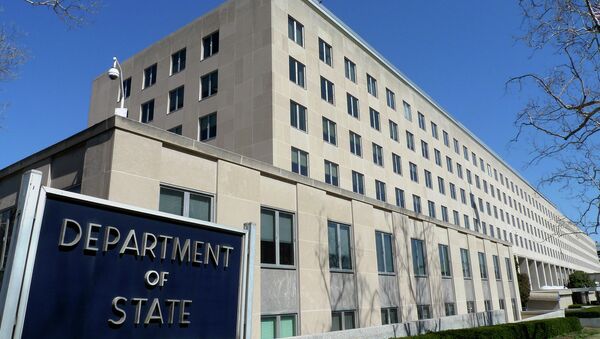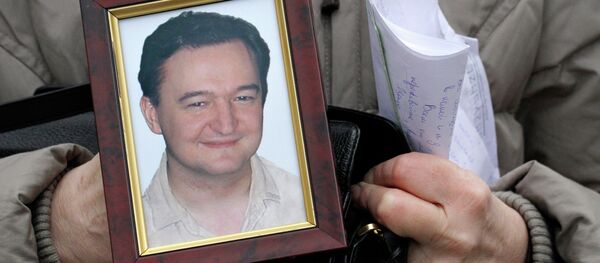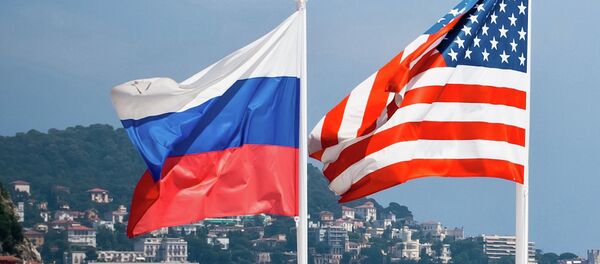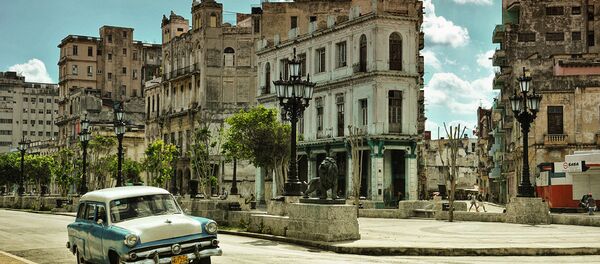MOSCOW, December 24 (Sputnik) — The United States has continued its decades-long tradition of using economic sanctions as a foreign policy tool in 2014. After the March referendum in Crimea on reunification with Russia, Washington introduced new restrictions against Moscow and has regularly added to the existing sanctions every couple of months. The most recent restrictions were imposed on investment and trade with Crimea on December 19.
RUSSIA
On April 12, 2013, the US Department of Treasury published a list of 18 representatives of Russia's law-enforcement bodies and judiciary. Those named are barred from entering the United States and their assets under American jurisdiction were frozen.
In May 2014 the United States considerably expanded the Magnitsky list, imposing sanctions against another 12 Russians it alleged were guilty of human rights violations.
On March 17, 2014, the United States imposed sanctions on high-ranking Russian politicians who it accused of contributing to Russia's alleged actions in Ukraine. These restrictions banned entry to the United States and a freezing of assets and property.
On March 20 the United States again expanded its list by adding the names of another 19 Russian officials, MPs and entrepreneurs.
On April 11 the United States imposed sanctions against the Crimean oil-and-gas company Chernomorneftegaz and Crimean officials.
On April 28 US authorities expanded the list of sanctions again.
In July the United States switched from individual sanctions against selected individuals to measures against entire sections of the Russian economy. On July 16 it imposed sanctions on several Russian defense and oil companies.
On July 29 the US Department of Treasury included in the list an additional three banks and Russia's United Shipbuilding Corporation.
On September 12 the United States blocked the assets of five Russian defense companies and tightened access to capital for six Russian banks.
On December 18, US President Barack Obama signed the 5859 Ukraine Freedom Support Act of 2014, which provides him with the authority to impose, at his discretion, additional restrictions on Russia. The aim of the Act is to provide the United States president with the authority to both impose additional sanctions on Russia and render more aid to Ukraine.
BELARUS
US sanctions against Belarus were first introduced when the Belarus Democracy Act was adopted in October 2004. The Act was an analysis of the Belarusian political situation and its legislation. Eleven paragraphs detailed the authoritarian nature of Alexander Lukashenko's regime.
The section on sanctions pointed out that, with the exception of humanitarian aid, the US government would not provide any loans, loan guarantees, insurance payments, financing and any other financial assistance to the Belarusian government.
In 2006, the US Congress passed the Belarus Democracy Reauthorization Act extending the sanctions for two more years and increasing funding to government opposition and independent media.
The Belarus Democracy and Human Rights Act was adopted in 2011. Out of 22 sections, 10 concerned the suppression of the December 19, 2010 rally, when 600 people were arrested, including four of the six presidential candidates. Law enforcement officers were added to the list of officials mentioned in the document. In addition, the United States urged the International Ice Hockey Federation to suspend its preparations for the 2014 World Cup in Minsk and imposed sanctions on some Belarusian enterprises, banning business dealings with them and freezing their assets.
In early 2012, entry into the United States was denied to President Lukashenko (the United States does not recognize him as a legitimate head of state), his two elder sons and certain Belarusian officials, 157 individuals in all. In 2013, the sanctions were extended for another year.
In 2014, US President once again extended the sanctions for another year.
CHINA
The United States introduced economic sanctions against China after a series of demonstrations by Chinese students on Beijing's Tiananmen Square between April 15 and June 4, 1989, were stopped by force. Washington implemented a package of measures to curb bilateral cooperation with China, intending to completely isolate the country. The US suspended all high-level contacts with China, stopped military exchanges and imposed a moratorium on the supply of arms and military equipment.
In June-July 1989 the US Congress approved a program of economic sanctions against China including the renunciation of many joint trade and economic projects. US President George H. W. Bush instructed US representatives in international financial agencies to suspend loans to China.
In 1993 the United States fully rescinded its policy of alienating China and moved toward a normalization of all relations.
CUBA
As of March 2014, the economic cost of the US blockade to Cuba amounted to $116.8 billion. An all-out trade embargo against Cuba was formally implemented by President John F. Kennedy on February 3, 1962, though it had already begun almost immediately following the January 1, 1959, Cuban Revolution. The Trading with the Enemy Act of October 6, 1917, which prohibits US citizens and companies from trading with countries that are at war with the United States, was applied to Cuba. The law is renewed annually.
In December 2014 President Obama began the process of formally recognizing Cuba and the start of diplomatic negotiations with the island nation. These talks have not currently suggested an easing of sanctions.
DPRK
Following the division of Korea into North and South in 1948 and the outbreak of the Korean War in 1950, the US applied the Export Control Act and the Trading with the Enemy Act, prohibiting export, trade and commercial exchanges, as well as canceling most favored nation status for North Korea. The laws prohibited the export of any US goods and technical services to the DPRK, even through third-party countries, without permission from the US Department of State. The assets of DPRK citizens in the US were frozen.
In June 2000, economic sanctions were eased: North Korea was able to export raw materials to the US, while US companies were able to invest in North Korea's agriculture, infrastructure and tourism.
On June 26, 2008, President George W. Bush lifted the ban on foreign trade. However, a number of unilateral restrictions on the DPRK introduced by the US remained in force. The assets of DPRK or North Korean individuals in the US that were frozen June 16, 2000, remain blocked.
The sanctions were extended in 2010 and 2011.
Following nuclear tests in the DPRK in February 2013, the US in March 2013 introduced a number of sanctions and froze the assets of three North Korean citizens employed by Tanchon Commercial Bank and Korea Mining Development Corporation (KOMID) representing the country's interests in China. According to US authorities, the two business entities were linked to North Korea's largest arms manufacturer.
Several days later, new unilateral sanctions were introduced against the North Korea Foreign Trade Bank, which is the country's primary foreign trade bank, over its role in supporting the development of nuclear weapons within the country.
Sanctions were also introduced against three high-ranking North Korean officials and two party functionaries.
IRAN
In 1979 the United States froze all Iranian assets and gold reserves in response to the seizure of the US Embassy in Tehran. Foreign companies that violated these restrictions were also subject to sanctions.
In 1980 the United States banned the exports of almost all goods to Iran, including food products and medicines. The US imposed an embargo on the import of goods from Iran and prohibited Americans from visiting Iran.
In 1984 a ban was imposed on loans to Iran by international financial agencies. In 1987 US-Iranian trade was halted.
In 1995 sanctions were lifted and Iran began to acquire American goods via third-party countries.
In 2005 the United States imposed several new sanctions, mostly against Iranian banks, as well as companies and individuals involved in Iran's nuclear program and arms industry.
In 2014 the United States weakened some economic sanctions against Iran. The Boeing Corporation received a government license to acquire spare parts for Iran's commercial aircraft.
IRAQ
After the end of the Iran-Iraq war (1980-1988), the United States banned exports to Iraq of equipment that could be used for military purposes.
In 1990, the United States imposed trade sanctions on Iraq, describing it as a country that supported terrorism.
The 1992 US law prohibited arms supplies to Iraq and authorized sanctions on countries involved in supplying what it called "destabilizing" arms to Iran.
In 2003, President George W. Bush lifted the 1990 sanctions.
LIBYA

On February 26, 2011, President Obama signed an executive order to introduce unilateral financial sanctions against Libyan leader Muammar Gaddafi, his government and family members. In accordance with the executive order, all assets and all bank accounts of Gaddafi, his government and four relatives were frozen, and a ban was introduced on all banking transactions with the Libyan government. The frozen assets are said to be in the amount of $30 billion.
On February 27, 2011, US State Secretary Hillary Clinton announced the introduction of visa sanctions against Gaddafi, members of his government and closest associates. The sanctions were imposed amid an armed uprising against the Gaddafi regime, which lasted about nine months. Gaddafi was killed in October 2011.
On December 16, 2011, most of the sanctions on Libya were lifted. The US administration released all blocked assets of the Central Bank of Libya except for the funds and assets of Gaddafi and his family, which remain frozen.
On February 24, 2012, President Obama renewed for another year several US sanctions imposed on the former Libyan leaders.
SYRIA
On May 11, 2004, pursuant to the Syria Accountability Act adopted by the US Congress, US President George W. Bush introduced a number of economic sanctions against Syria.
Bush accused the Syrian leadership of supporting terrorism, occupying Lebanon, implementing programs to create weapons of mass destruction and undermining international efforts to stabilize Iraq.
In April and May 2006, the US sanctions against Syria were expanded.
On February 14, 2008 President Bush issued an executive order freezing the assets of several Syrian citizens, including high-ranking Syrian government officials.
On April 29, 2011, the US introduced sanctions against an additional number of Syrian officials and government agencies, which, according to the US administration, violated human rights in the country. The sanctions came in response to the suppression of anti-government protests in Syria.
On May 18, 2011, the US announced sanctions against Syrian President Bashar Assad over alleged human rights violations.
On April 23, 2012, the US introduced sanctions against individuals and organizations helping Syrian and Iranian authorities to use modern information technology to monitor citizens" private life, thus violating their rights.
On July 18, 2012, following a terrorist attack in the Syria National Security Service building in Damascus, which killed and injured several Syrian security and law enforcement officials, the US authorities further expanded Syria sanctions.
In June 2013, the US eased sanctions on Syria to support the Syrian opposition.
In May 2014, US President Barack Obama announced the extension of sanctions against Syria for one year, including the ban on the export and re-export of a number of Syrian goods. The US continued to block the assets of a number of Syrian officials.
In October 2014, the sanctions list was expanded.
YEMEN
In November 2014, the US government imposed sanctions on former president of Yemen Ali Abdullah Saleh and Houthi leaders Abdullah Yahya al-Hakim and Abd al-Khalid al-Houthi, who, according to the US government, were involved in activities that directly or indirectly threatened peace, security and stability in Yemen. Their assets in the United States were frozen, and they were denied entry into the United States. In addition, US companies and individuals residing in the United States were prohibited from doing business with them.
OTHER COUNTRIES SANCTIONED BY THE UNITED STATES
At different times, the US administration has introduced sanctions against Burma, Zimbabwe, Cote d'Ivoire, the Democratic Republic of Congo, Lebanon, Somalia, Sudan and South Sudan.










